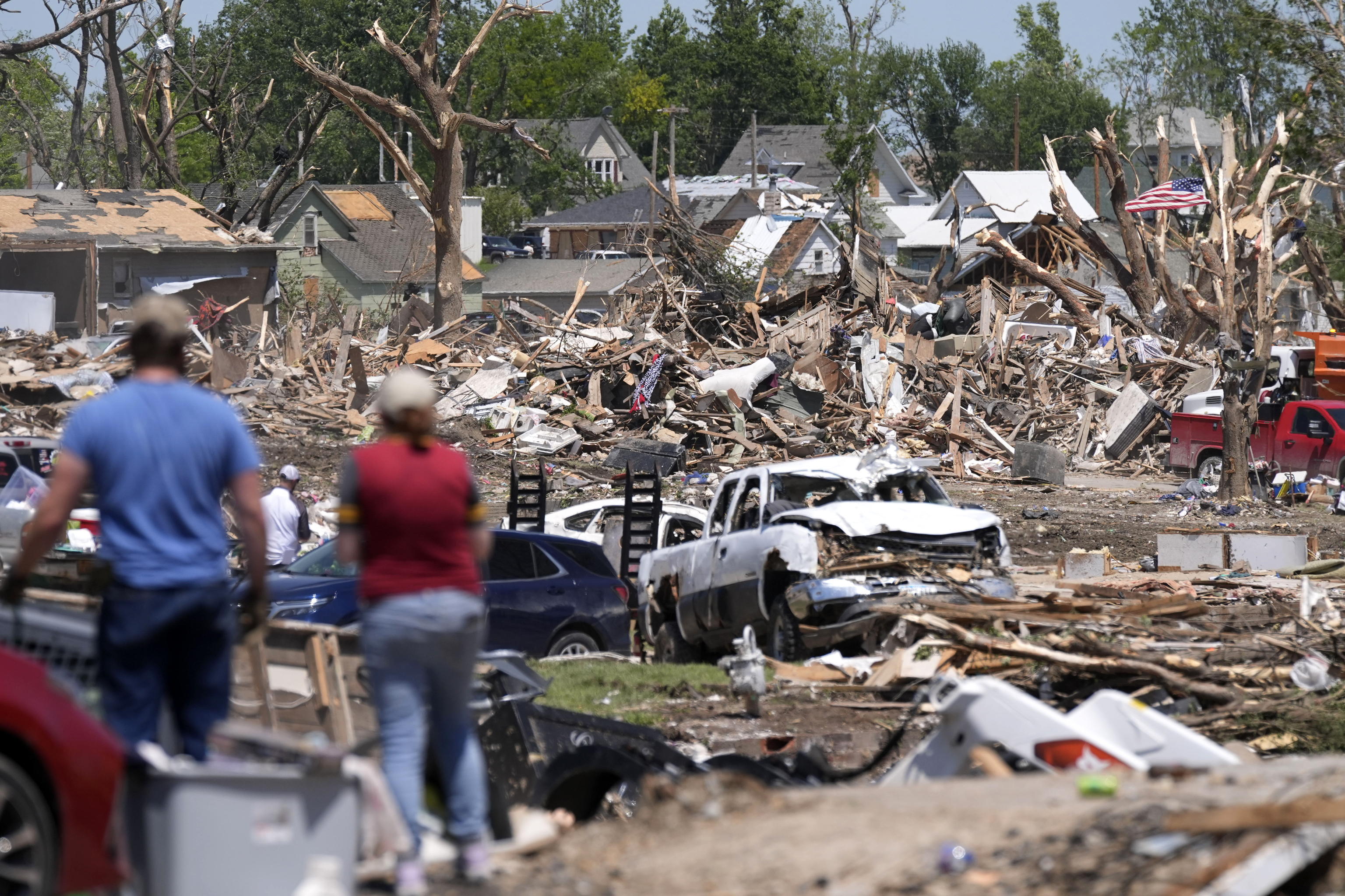All along the mile-long swath Thursday was the deafening clamor of heavy equipment scooping up the splintered homes, smashed vehicles and shredded trees. But on either side of that path, picturesque houses and lawns seem untouched, and one might be hard-pressed to believe a twister packing peak winds of 175-185 mph (109-115 kph) had ravaged the community of 2,000, killing four people and injuring at least 35.
More than 202 homes were destroyed by a series of tornadoes that raked the state on Tuesday, Iowa Gov. Kim Reynolds said Thursday at a news conference. Most were in and around Greenfield. The count does not include businesses or other buildings destroyed or damaged, like Greenfield's 25-bed hospital.
The havoc spun by the tornado now shows on the faces of people still processing how quickly homes and lives were shattered.
"It's like somebody took a bomb," said Bill Yount, 64, gesturing to the land — covered with wood, debris, trees stripped of their leaves, heavy machinery and equipment to clean up the mess — outside his house in Greenfield.
Yount's house was the only one "that really survived. And I don't know why," Yount said, pointing to the devastated remains of his neighbors' homes.
Also surveying the damage was 80-year-old Edith Schaecher, who was briefly trapped in her collapsed house with her daughter until neighbors helped them out. They sought shelter in a basement concrete shower, holding pillows over their heads to protect from the falling debris.
"It was over within probably 30 seconds," she said, destroying the home where she had lived for 47 years.
Schaecher's neighbor, Joan Mitchell, was with her 57-year-old son in the home she'd lived in for 10 years when the tornado roared through.
She had ignored the tornado warnings — until she was knocked to the floor and two recliners flew on top of her.
"I kept praying and praying, and after that I started hollering, 'Help! Help! Help!'" Mitchell recalled. Both she and her son survived with bumps and bruises.
The governor praised the Federal Emergency Management Agency's response on Thursday as she sought a disaster declaration for multiple counties. After surveying Tuesday's destruction, the National Weather Service determined that three separate powerful tornados carved paths totaling 130 miles (209.21 kilometers) across Iowa, according to Donna Dubberke, the meteorologist in charge in Des Moines.
Colton Newbury, 24, was working in Des Moines when the twister hit, nearly 60 miles (97 kilometers) away from his wife and 10-month-old daughter at their home in Greenfield.
He rushed back only to find their home was "a hole in the ground," he said. His wife hadn't heard the sirens. Newbury said his cousin ran out to get his wife and baby, and they rode out the tornado in the cousin's basement. The winds pulled entire homes away, he said: "About every house on the block, just foundations left."
Still more severe weather was moving across the Midwest. The weather service's Storm Prediction Center shows an enhanced severe storm risk late Thursday into Friday morning for much of Nebraska and western Iowa, including areas where tornadoes hit Iowa and hurricane-force winds, large hail and torrential rain flooded streets and basements in Nebraska.
This latest band of severe weather — including possible tornadoes — will hit Iowa "when people are sleeping," warned NWS meteorologist Andrew Ansorge of Des Moines.
"Because of the damage already there, it won't take much wind to inflict even more damage on these homes," Ansorge said. "It's just a bad deal all the way around."
More severe weather also could hit Saturday and Sunday in storm-damaged parts of Texas, Oklahoma and Kansas. An emergency was declared in Temple, Texas, after powerful storms ripped through the city of more than 90,000. Thousands lost power, Thursday's classes were canceled and nearby Fort Cavazos reported debris blocking traffic at the Army installation.
Before Tuesday's twister in Greenfield, this year's deadliest tornado was the one that killed three people in Logan County, Ohio on March 14. The Greenfield tornado set a new grim record as it obliterated homes and crumpled massive power-producing wind turbines outside the city.
The Greenfield tornado, initially rated an EF-3, was identified Thursday as the third EF4 tornado of 2024, with the first in Marietta-Lake Murray, Oklahoma, in April and the second in Barnsdall, Oklahoma, earlier this month. On average there are three or four EF4 tornadoes a year with a record high of 13 in 2011, according to Storm Prediction Center Warning Coordination Meteorologist Matt Elliott.
It was so destructive that it took authorities more than a day to account for the area's residents, and Iowa's Department of Public Safety said the number of injured is likely even higher. Officials haven't yet released the names of the Greenfield victims.
A fifth person was killed Tuesday about 25 miles (40 kilometers) from Greenfield when her car was blown off the road in a tornado, according to the Adams County Sheriff's Office. Monica Zamarron, 46, died in the crash Tuesday afternoon, officials said.
Reynolds has requested an expedited presidential disaster declaration for those Iowa counties that sustained significant damage. FEMA Administrator Deanne Criswell joined her at the news conference in Greenfield and said that her agency will process the request as quickly as possible to get resources — which could include funding for temporary housing — to those left without homes.
This is a historically busy tornado season in the U.S., in an era when climate change is heightening the severity of storms around the world. April had the country's second-highest number of tornadoes on record.
Through Tuesday, 859 tornadoes had been confirmed this year, 27% more than the U.S. sees on average, according to NOAA's Storm Prediction Center in Norman, Oklahoma. Iowa has recorded the most, with 81 confirmed twisters.
